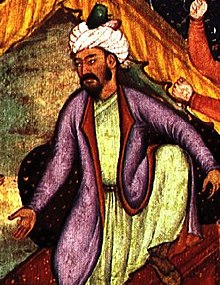| Barlas برلاس | |
|---|---|
| Parent house | Borjigin |
| Country | Transoxiana |
| Founder | Qarachar Barlas |
| Titles | Khan Sheikh Mirza Beg Shah Sardar Emir Ghazi Sultan |
| Estate(s) | Kesh; Samarkand |
| Cadet branches | Timurid |
The Barlas (Mongolian: Barulās; Chagatay/Persian: برلاس Barlās; also Berlās) were a Mongol and later Turkicized nomadic confederation in Central Asia. With military roots in one of the regiments of the Mongol army, the Barlas spawned two major imperial dynasties in Asia: the Timurid Empire in Central Asia and Persia; and its later branch, the Mughal Empire in the Indian subcontinent.
Origins

According to the Secret History of the Mongols, written during the reign of Ögedei Khan , the Barlas shared ancestry with the Borjigin, the imperial clan of Genghis Khan and his successors, and other Mongol clans. The leading clan of the Barlas traced its origin to Qarachar Barlas, head of one of Chagatai's regiments. Qarachar Barlas was a descendant of the legendary Mongol warlord Bodonchir (Bodon Achir; Bodon'ar Mungqaq), who was also considered a direct ancestor of Genghis Khan. The internal structure of the Barlas' leading clan consisted of five major lineages– tracing back to the sons of Qarachar– who were important in matters of inheritance but did not constitute separate political or territorial entities.
The Barlas controlled the region of Kish (modern Shahrisabz, Uzbekistan) and all of its lineages seem to have been associated with this region. In contrast to most neighboring tribes who remained nomadic, the Barlas were a sedentary tribe. Due to extensive contacts with the native population of Central Asia, the tribe had adopted the religion of Islam, and the Chagatai language, a Turkic language of the Qarluq branch, which was heavily influenced by Arabic and Persian. Although the Barlas were not always exogamous, most marriages recorded were outside the tribe.
Timurids and Mughals
Main articles: Timurid dynasty and Mughal dynastyIts most famous representatives were the Timurids, a dynasty founded by the conqueror Timur in the 14th century, who ruled over modern-day Iran, Armenia, Azerbaijan, Georgia, and almost the entire rest of the Caucasus, Afghanistan, much of Central Asia, as well as parts of contemporary Pakistan, Mesopotamia, and Anatolia. One of his descendants, Babur, later founded the Mughal Empire of Central Asia and South Asia.
See also
References
- ^ Grupper, S. M. 'A Barulas Family Narrative in the Yuan Shih: Some Neglected Prosopographical and Institutional Sources on Timurid Origins'. Archivum Eurasiae Medii Aevi 8 (1992–94): 11–97
- ^ B.F. Manz, The rise and rule of Tamerlan, Cambridge University Press, Cambridge 1989, p. 28: "... We know definitely that the leading clan of the Barlas tribe traced its origin to Qarachar Barlas, head of one of Chaghadai's regiments ... These then were the most prominent members of the Ulus Chaghadai: the old Mongolian tribes — Barlas, Arlat, Soldus and Jalayir ..."
- ^ M.S. Asimov & C. E. Bosworth, History of Civilizations of Central Asia, UNESCO Regional Office, 1998, ISBN 92-3-103467-7, p. 320: "... One of his followers was Timur of the Barlas tribe. This Mongol tribe had settled in the valley of Kashka Darya, intermingling with the Turkish population, adopting their religion (Islam) and gradually giving up its own nomadic ways, like a number of other Mongol tribes in Transoxania ..."
- G.R. Garthwaite, "The Persians", Malden, ISBN 978-1-55786-860-2, MA: Blackwell Pub., 2007. (p.148)
- Gérard Chaliand, A Global History of War: From Assyria to the Twenty-First Century, University of California Press, California 2014, p. 151
- The Secret History of the Mongols, transl. by I. De Rachewiltz, Chapter I Archived February 23, 2007, at the Wayback Machine.
- B.F. Manz, The rise and rule of Tamerlan, Cambridge University Press, Cambridge 1989, p.157
- B.F. Manz, The rise and rule of Tamerlan, Cambridge University Press, Cambridge 1989, p. 156–7
- Gérard Chaliand, A Global History of War: From Assyria to the Twenty-First Century, University of California Press, California 2014, p. 151
- G. Doerfer, "Chaghatay Archived November 18, 2007, at the Wayback Machine", in Encyclopædia Iranica, Online Edition 2007.
- B.F. Manz, The rise and rule of Tamerlan, Cambridge University Press, Cambridge 1989, p. 157
- René Grousset, The Empire of the Steppes: A History of Central Asia, Rutgers University Press, 1988. ISBN 0-8135-0627-1 (p.409)
- "Ẓahīr-al-Dīn Moḥammad Bābor" at Encyclopædia Iranica
| Mongolic peoples | |||||||||||
|---|---|---|---|---|---|---|---|---|---|---|---|
| History | |||||||||||
| Proto-Mongols | |||||||||||
| Medieval tribes | |||||||||||
| Ethnic groups |
| ||||||||||
| See also: Donghu and Xianbei · Turco-Mongol · Modern ethnic groups Mongolized ethnic groups.Ethnic groups of Mongolian origin or with a large Mongolian ethnic component. | |||||||||||
| Turco-Mongol | |
|---|---|
| States | |
| Related ethnic groups and clans | |
| Culture | |
| Origin is controversial. | |